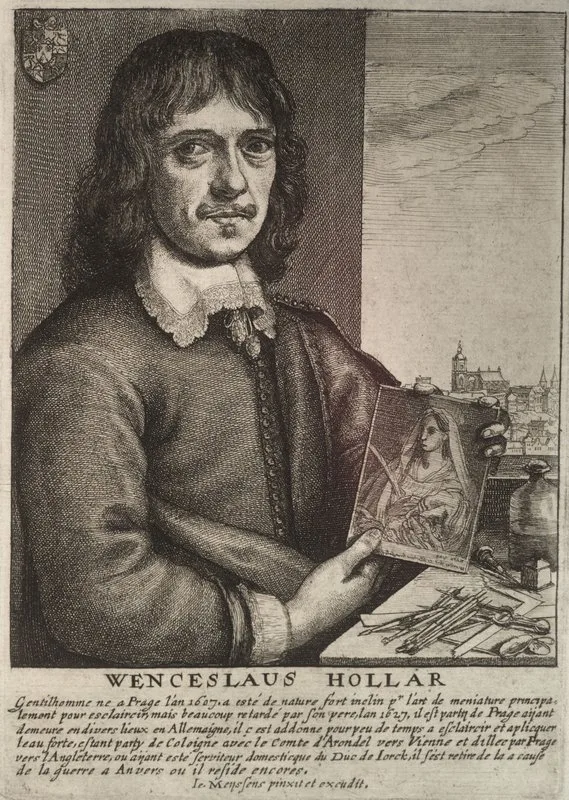
1607–1677
Movements
Occupations
Wenceslaus Hollar (1607-1677) was a prolific Bohemian etcher who became one of the most accomplished printmakers of the seventeenth century. Born in Prague, he trained under Matthäus Merian in Frankfurt before entering the service of Thomas Howard, Earl of Arundel, in 1636. Hollar spent most of his career in England, where he produced approximately 2,740 etchings documenting an extraordinary range of subjects. His meticulous topographical views of London before and after the Great Fire of 1666 provide irreplaceable historical documentation. Unlike many Baroque contemporaries, Hollar favored precise observation over theatrical effects, employing delicate linework to capture intricate textures in fur, lace, and architectural details. His costume studies, natural history illustrations, and architectural views represent invaluable records of seventeenth-century visual culture. Despite financial struggles throughout his life, Hollar's technical mastery and comprehensive documentation established him as a pivotal figure in printmaking history.
Born July 23, 1607, in Prague, into a family originally destined for the legal profession, but turned to art after his family was ruined during the Sack of Prague in the Thirty Years' War
Created earliest known works in 1625-1626, including a copy of Dürer's "Virgin and Child," demonstrating early influence of Dürer's detailed draughtsmanship that would define his career
Apprenticed with renowned engraver Matthäus Merian in Frankfurt in 1627, mastering the bird's-eye view technique and copper engraving in Europe's leading print workshop
Traveled extensively through Germany (1630-1636), working in Strasbourg, Mainz, Koblenz, and Cologne, producing topographical views of towns, castles, and landscapes of the Middle Rhine Valley
Absorbed influences from Prague's artistic milieu shaped by Emperor Rudolf II's court collections, including works by Aegidius Sadeler II, who likely provided early training in etching techniques
Met Thomas Howard, Earl of Arundel, in Cologne in 1636 during a diplomatic mission; Arundel recognized Hollar's technical proficiency and hired him to create a visual inventory of his extensive art collection
Accompanied Arundel on diplomatic mission to Vienna and Prague, then settled in England in 1637, working at Arundel House on the Strand to document the earl's renowned collection through etchings
Produced seminal costume series "The Severall Habits of English Women" (late 1630s) documenting fashion from nobility to country women, establishing himself as a meticulous recorder of contemporary dress
Created "The Four Seasons" series (1641), featuring elaborately costumed women representing seasonal dress, showcasing his masterful ability to render textures like lace and fur through etching
During English Civil War, joined Royalist forces and endured the siege of Basing House (1643-1645) alongside fellow royalist artists Inigo Jones and William Faithorne, producing over 100 plates during this period of enforced leisure
Captured by Parliamentary forces in 1645 during the fall of Basing House; subsequently relocated to Antwerp where he reconnected with the exiled Earl of Arundel
Produced some of his most acclaimed works in Antwerp, including intricate cityscapes, seascapes, detailed shell studies, and exquisite fur muff still lifes demonstrating his fascination with texture
Created the monumental "Long View of London" (1647), a five-meter panorama from Whitehall to the Tower of London, etched from memory and earlier sketches, dedicated to Princess Mary
Published views of major European cities including his "Great View of Prague" (1649) and detailed rendering of the Cathedral of Our Lady of Antwerp (1649)
Continued to develop his technique of combining etching with hand-engraving, achieving unprecedented detail in reproducing minute textures such as individual hairs in fur
Returned to London in 1652, working for various publishers and illustrators after Earl of Arundel's death in 1646 ended his primary patronage
Appointed "His Majesty's Designer" by Charles II following the Restoration in 1660, gaining official recognition though financial security remained elusive
Documented the Great Fire of London (1666), producing invaluable "Views of London" showing the city's devastation and transformation, creating essential historical records of lost architecture
Traveled to Tangier, Morocco, in 1669 as official artist on Lord Henry Howard's expedition, returning in 1670 with African studies despite advancing age and deteriorating eyesight
Died in poverty on March 28, 1677, at his home on Gardiner's Lane, Westminster; buried at St. Margaret's Church, Westminster, leaving a legacy of over 2,740 etched plates documenting seventeenth-century life
Artheon Research Team
Last updated: 2025-11-28
Biography length: ~1,847 words
Wikidata/Wikimedia Commons